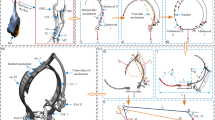Abstract
Motion camouflage is a stealth behaviour observed both in hover-flies and in dragonflies. Existing controllers for mimicking motion camouflage generate this behaviour on an empirical basis or without considering the kinematic motion restrictions present in animal trajectories. This study summarises our formal contributions to solve the generation of motion camouflage as a non-linear optimal control problem. The dynamics of the system capture the kinematic restrictions to motion of the agents, while the performance index ensures camouflage trajectories. An extensive set of simulations support the technique, and a novel analysis of the obtained trajectories contributes to our understanding of possible mechanisms to obtain sensor based motion camouflage, for instance, in mobile robots.
Similar content being viewed by others
References
Alexander RM (2003) Principles of animal locomotion. Princeton University Press, Princeton
Anderson A (2003) Sensory motor neural systems for a predatory stealth behaviour camouflaging motion. PhD thesis, Computer Science, Queen Mary University of London
Anderson A, McOwan P (2003a) Humans deceived by predatory stealth strategy camouflaging motion. Proc R Soc Lond B 270(Suppl 1): S18
Anderson A, McOwan P (2003b) Model of a predatory stealth behaviour camouflaging motion. Proc R Soc B 270: 489–495
Arechavaleta G, Laumond JP, Hicheur H, Berthoz A (2008) An optimality principle governing human walking. IEEE Trans Robot 24(1): 5–14
Boeddeker N, Egelhaaf M (2003) Steering a virtual blowfly: simulation of visual pursuit. Proc R Soc 270: 1971–1978
Carey N (2007) Biomimetic strategies for motion camouflage. PhD thesis, Australian National University
Carey N, Ford J, Chahl J (2004) Biologically inspired guidance for motion camouflage. In: Proceedings asian control conference 3, vol 3, pp 1793–1799
Firsby JB, Stone JV (2010) Seeing. The computational approach to biological vision. The MIT Press, Cambridge
Fox D, Burgard W, Thrun S (1997) The dynamic window approach to collision avoidance. IEEE Robot Autom Mag 4(1): 23–33
Fraenkel G, Gunn D (1961) The orientation of animals. Kineses, taxes and compass reactions. Dover publications, New York
Franceschini N, Pichon J, Blanes C, Brady J (1992) From insect vision to robot vision [and discussion]. Phil Trans R Soc Lond B 337: 283–294
Glendinning P (2003) The mathematics of motion camouflage. Proc R Soc B 271: 477–481
Justh EW, Krishnaprasad PS (2006) Steering laws for motion camouflage. Proc R Soc A 462: 3629–3643
Kirk D (2004) Optimal control theory. An introduction. Dover publications, New York
Latombe JC (1991) Robot Motion planning. Kluwer, Norwell
McLeod P, Dienes Z (1993) Running to catch the ball. Nature 362: 23
Mizutani A, Chahl J, Srinivasan M (2003) Insect behaviour: motion camouflage in dragonflies. Nature 423: 604
Rañó I (2009) A steering taxis model and the qualitative analysis of its trajectories. Adapt Behav 17(3): 197–211
Rañó I, Burbridge C (2010) Motion camouflage for unicycle robots using optimal control. In: Proceedings of TAROS
Rañó I, Burbridge C (2011) Two dimensional motion camouflage for unicycle robots. In: International workshop on bio-inspired robots
Rañó I, Nehmzow U, Iglesias R (2009) Application of system identification to the implementation of motion camouflage in mobile robots. Tech. Rep. RR-09-01, Computer Sciences and Systems Engineering Dept. University of Zaragoza
Reddy PV, Justh EW, Krishnaprasad P (2006) Motion camouflage in three dimensions. In: IEEE conference on decision and control, pp 3327–3332
Reynolds C (1999) Steering behaviors for autonomous characters. In: Proceedings of the 1999 game developers conference. Miller Freeman Game Group, San Francisco, pp 763–782
Russell S, Norvig P (1996) Artificial intelligence. A modern approach. Prentice Hall, Englewood Cliffs
Srinivasan M (1995) Strategies for visual navigation, target detection and camouflage: inspirations from insect vision. In: IEEE international conference on neural networks, vol 5, pp 2456–2460
Webb B (2000) What does robotics offer animal behaviour. Animal Behav 60: 545–558
Webb B (2001) A spiking neuron controller for robot phonotaxis. In: Consi TR, Webb B (eds) Biorobotics. The MIT/AAAI Press, Menlo Park, pp 3–20
Author information
Authors and Affiliations
Corresponding author
Rights and permissions
About this article
Cite this article
Rañó, I. An optimal control strategy for two-dimensional motion camouflage with non-holonimic constraints. Biol Cybern 106, 261–270 (2012). https://doi.org/10.1007/s00422-012-0493-7
Received:
Accepted:
Published:
Issue Date:
DOI: https://doi.org/10.1007/s00422-012-0493-7




